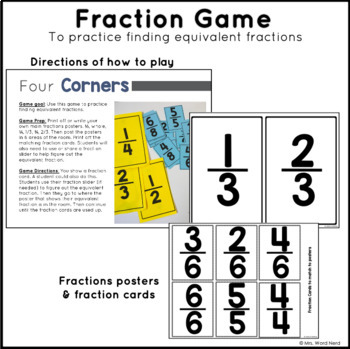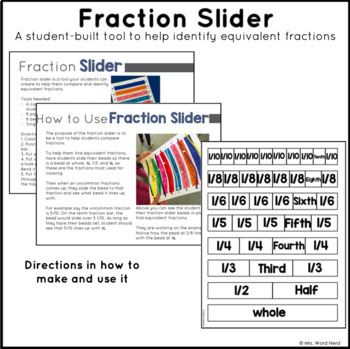Equivalent Fractions | Comparing Activities & Games Cooking with Fractions
What educators are saying
Description
We know that fractions especially equivalent fractions can be tricky for students. Where is one place that fractions are frequently found? …the kitchen. So why not get your students cooking with equivalent fractions?
In this product, students get hands-on practice finding equivalent fractions with a tool they create called the fraction slider. They play a version of Four Corners to practice finding equivalent fractions. They use their skills to rewrite mixed up recipes with uncommon fractions so they can actually make the recipes.
This product was created after my second grade smarties a few years ago realized the connection between fractions and cooking. This was what I created to help them work with fractions and take on cooking tasks.
Why you will love this product?
→ Students get hands-on practice identifying & understand what are equivalent fractions
→ Fraction slider tool that can be used throughout fraction unit
→ Students get to move while learning
→ Students get hands-on learning and practicing life cooking skills
→ Has students working together to create something yummy or fun
In this unit you will find
→ Measuring Tools for Cooking Posters
→ Equivalent Fraction poster
→ Four Corners equivalent fraction game
→ Fraction slider and directions
→ 7 recipes in three versions- normal, mixed up fractions and blank to use for recording the correct fractions
→ Ideas on how to extend fraction work with these recipes
→ Teacher and Recipe Notes to help you in planning out using this resource
Recipes are all ones I have used in my classroom over the years. They are:
→ Gingerbread Playdough
→ Oobleck
→ Fruit Yogurt Dip
→ Berry Muffins
→ Pumpkin Granola
→ Healthy Energy Balls
→ Ranch Dressing
Time to get cooking and finding those fractions!
See preview for a sneak peek!
♦ ♦ ♦ ♦ ♦ ♦ ♦ ♦ ♦ ♦ ♦ ♦ ♦ ♦ ♦ ♦ ♦ ♦ ♦ ♦ ♦ ♦ ♦ ♦ ♦ ♦ ♦ ♦ ♦ ♦ ♦ ♦ ♦ ♦ ♦ ♦ ♦ ♦ ♦ ♦ ♦ ♦ ♦ ♦ ♦ ♦ ♦ ♦ ♦
Other Math Projects for you!
★ Need an engaging measurement activity that involves movement, graphing, and animal research? Check out Jump, Jump, Jump Around
★ Want to add a simple STEM project to your measurement unit? Check out Paper Chain Challenge-Math STEM Project
★ Are you in need of a fun and engaging place value project that allows students to use their imagination? Check out Place Value Math Monsters
★ Do you need to spice up your practicing of double facts? Check out Double Facts Math Monsters
♦ ♦ ♦ ♦ ♦ ♦ ♦ ♦ ♦ ♦ ♦ ♦ ♦ ♦ ♦ ♦ ♦ ♦ ♦ ♦ ♦ ♦ ♦ ♦ ♦ ♦ ♦ ♦ ♦ ♦ ♦ ♦ ♦ ♦ ♦ ♦ ♦ ♦ ♦ ♦ ♦ ♦ ♦ ♦ ♦ ♦ ♦ ♦ ♦
Thank you so much for taking the time to stop and look! ♥ Jessica
I’d LOVE to connect with you!
Click the green ★ to follow my store and be the first to learn about new products and freebies! You will then receive updates from me.
Did you know you earn TpT credit towards future purchases when leaving feedback? If you take the time to provide feedback I would be thrilled and your next purchases could be quite the deal!





